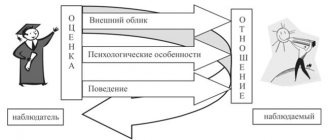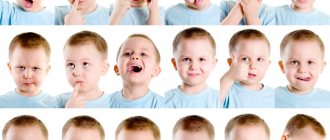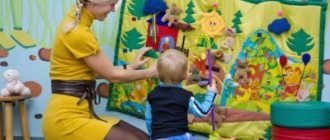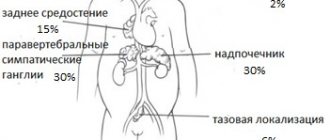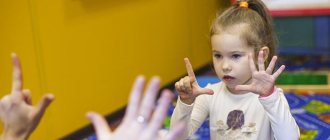Classification and examples
The classification of thinking reflects its development in a person as his nervous system and psyche develop.
There are several types of thinking:
Visually effective
This form develops in humans earlier than others and is typical for children in the first years of life.
The essence of this thinking comes down to specific actions through which the environment is cognized.
At the same time, the individual develops “yes-no” attitudes , that is, which actions carry something useful and important, why they are worth repeating and saying “yes” to them, and which ones, on the contrary, can cause harm, so they should be avoided.
In this way, the first experience based on actual knowledge is formed.
The development of this type of thinking is no coincidence in early childhood, when the child learns about the world through the senses and his own manipulations: crawling, touching, tasting and touching.
In this case, sensations arise from all senses, which creates the information base for this type of thinking.
However, it is also relevant in adulthood, but as an element of thinking: observing the actions of an object forms a visual image, and one’s own active experience also works.
We can say that this type is more primitive and simple, but is quite effective in certain situations : learning motor skills, mastering work that requires fine motor skills, imitative learning and behavior.
Example : recognition of moving objects by a child by a characteristic sound (mother’s voice), in adulthood avoiding contact with aggressive people or an angry dog in order to avoid conflict (experimentally - undesirable consequences have been established by action or such have been observed).
Visual-figurative
It is formed next , at the age of three years. With this type of thinking, there is no longer a need to touch an object and perform some action with it; instead, a person begins to imagine how he would do it and feel it.
That is, the individual forms images. And this is no coincidence. In early childhood, there is a rich accumulation of information obtained strictly experimentally by “examining” and “feeling” the surrounding world.
Upon reaching a certain amount of such knowledge, the child begins to think through and imagine both a phenomenon or object, and an entire situation. Closely related to this is the rapid development of imagination in childhood, which can also be represented as visual-figurative thinking.
At the same time, there is still no ability to abstract from the situation and add a conceptual perception of reality.
Visual-figurative thinking in adulthood is actively used by people in creative professions , as well as in everyday life, which includes direct observation of the world with the help of ideas and images in conditions of lack of information.
Example : presentation of the result of a simple mosaic when playing for children; for adults, planning the interior of an apartment in accordance with the images.
Subject-specific
It occupies the next step in the evolution of thinking and is actively formed at the age of 5-7 years.
It is also called concrete-actional because the implementation of this thinking is carried out in some professional working or training conditions, when a person models an action based on ideas and images.
In this way, skills are developed in childhood and the work and educational process in older age is structured.
This type is, as it were, a synthesis of the two previous ones: knowledge of the world occurs through action, and this is also the final result, but this is realized with the help of visual, concrete images.
Example : learning to ride a bicycle or swimming for a child; for adults, completing a plan - tasks at work or school.
Abstract-logical
It is the crown of development and is formed at an older age, when skills such as the ability to formulate concepts and abstractions develop.
In this case, a person does not need to see or imagine anything based on experience; he is able to synthesize information himself by comparing the available data.
Abstraction is a complex process of representing concepts and phenomena that cannot be seen in the surrounding natural world. Logic is an abstract example.
In this case, logical connections, identification and construction of patterns are actively used. This type of thinking is based on the developed mental abilities of the individual and his emotional maturity.
In adults, abstract logical thinking is a leading component of working professional life, but its formation begins in adolescence.
Example : solving mathematical and logical problems, scientific activities.
In an adult, all of these types of thinking can be used in certain situations when they are appropriate.
Concept as a form of knowledge
Starting with visual-figurative thinking, the formation of such a form of cognition as a concept .
The concept means the unification of any properties that characterize something whole - a phenomenon or an object.
This object or phenomenon is determined by individual features and their relationships, that is, they are the defining characteristics. Conceptuality deciphers meaning and helps in identification.
To form such a perception tool, it is necessary to accumulate visual and practical data about the world, which allows them to be synthesized into something collective and new.
The concept is actively used in abstract-logical and objective-effective thinking.
Transition in children
The moment of transition from visual-effective to visual-figurative thinking is not always possible to accurately establish , since both of these types are closely interrelated with each other.
However, the development of visual-figurative appearance is closely related to the improvement of visual function and perception, which can be characterized by reactions of recognition of objects and subjects.
Visual-figurative thinking actively begins to develop when playing with a child begins, when he needs to imagine some kind of image of the result and the way to achieve it.
At this time, it is possible to solve the simplest practical problems: for example, assemble a puzzle or a whole picture according to ideas.
The transition of thinking is difficult to force , since the development of the nervous system has a physiological time period, but visual cognition can be actively developed with the help of various toys, pictures and other developmental tools.
When does it start to form?
Important. A visually effective form of thinking is actively formed in children of the earliest and youngest preschool age.
This process starts when the child cannot yet plan anything on his own. The first “symptoms” of this form of thinking can be observed even in seven-month-old babies. Information about the level of development in a child up to three years of age is provided by the period when the child solves problems related to objects and toys.
At three years old, a child can already plan something. Even if these are not the most daring and confident plans yet.
From cubes and fragments of the construction set, he can already build different structures - from houses to airplanes. He takes his toys apart to find out what they are made of, and “puts things in order” in his home closets. This is exactly how a complex but educational life-long journey begins with visually realistic thinking.
Development of visual-figurative thinking in preschool age
The development of thinking in preschoolers is closely related to the development of their visual system.
It has been proven that children with vision problems coped more slowly with the tasks of representing and using images.
Whereas children with good vision coped better and faster . This has a completely logical explanation: clearly distinguishing objects provides more detail and, accordingly, more information.
Also, parents and their participation in the child’s life play a big role in the development of visual-figurative thinking. Walking together, getting new visual impressions, and educational games make a huge contribution to the development of this type of thinking.
By the age of 3-4, the child is already actively imagining previously seen objects , and at an older age he is capable of fantasizing and imagining.
This stage actively develops during the socialization of the individual in preschool groups, where educational elements and there is active communication and exchange of experience with peers.
Diagnostics
To assess the degree of development of visual-figurative thinking, there are several simple methods:
- The method of absurd images: the child is asked to use a picture to reproduce the absurdity of the situation in which the hero in the picture finds himself.
These pictures depict various animals performing actions that are unusual for them (a mouse running away from a cat, for example). The child must answer the questions why he decided that the picture does not correspond to real life and how it should be in nature, that is, imagine another version of the development of events and establish structural and logical connections. If he copes with seven or more tasks, then thinking is assessed as highly developed. - Contouring : the task is given to complete the image. The pictures chosen are simple and familiar to the child: toys, geometric shapes, animals. At the same time, the speed and accuracy of the reaction is assessed. If he can do it in one and a half minutes, this indicates a developed visual-figurative perception of the surrounding world.
- “Assemble a picture” - the child is asked to choose the completion of the image from the proposed options. Here, simple and familiar fragments are also selected; to successfully restore the whole picture, you need to use your imagination and memory, as well as apply the elimination method. This test is considered successful if the child correctly selects the fragments within a few minutes.
- “Extra” - this technique is based on finding what is common and different and choosing an extra image. Pictures that are similar for certain groups of characteristics may be given, in which you need to choose an option that is not suitable for the entire group.
Leading type of thinking
Senior preschool age is a period of 5-6 years. A unique time for a baby who absorbs information like a sponge. The leading type of thinking in children of senior preschool age is visual and figurative, but logical thinking is already beginning to take shape. The child becomes able to work with simple diagrams and tables, draw conclusions, find commonalities between objects, and can choose the correct answers in complex tasks.
Drawing lesson on the topic “Professions” in senior groups
The preschooler begins to think more and more, imagining objects; he no longer necessarily has to constantly see what is the subject of his thoughts. Thinking becomes more flexible, the frame that previously seemed to hinder development disappears. Prerequisites appear to explain this or that phenomenon, to determine the laws of the process.
It's important to understand. Children with mental retardation (MDD) may have lower intelligence compared to their peers, therefore, the teacher and, first of all, the parents are required to make great efforts in developing the child’s thinking.
Any developmental disorder that parents notice should not go unnoticed by a specialist, who, as a result of the examination, may indicate developmental delay. Such children need additional classes (art, rhythm, salt dough, design), which will be a good stimulus for development.

